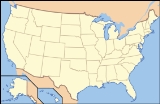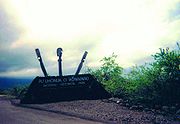
Pu'uhonua o Honaunau National Historical Park
Encyclopedia


United States
The United States of America is a federal constitutional republic comprising fifty states and a federal district...
National Historical Park
National Historical Park
National Historic Sites are protected areas of national historic significance in the United States. A National Historic Site usually contains a single historical feature directly associated with its subject...
located on the west coast of the island of Hawaii
Hawaii (island)
The Island of Hawaii, also called the Big Island or Hawaii Island , is a volcanic island in the North Pacific Ocean...
in the U.S. state
U.S. state
A U.S. state is any one of the 50 federated states of the United States of America that share sovereignty with the federal government. Because of this shared sovereignty, an American is a citizen both of the federal entity and of his or her state of domicile. Four states use the official title of...
of Hawaii
Hawaii
Hawaii is the newest of the 50 U.S. states , and is the only U.S. state made up entirely of islands. It is the northernmost island group in Polynesia, occupying most of an archipelago in the central Pacific Ocean, southwest of the continental United States, southeast of Japan, and northeast of...
. The historical park preserves the site where, up until the early 19th century, Hawaiians
Native Hawaiians
Native Hawaiians refers to the indigenous Polynesian people of the Hawaiian Islands or their descendants. Native Hawaiians trace their ancestry back to the original Polynesian settlers of Hawaii.According to the U.S...
who broke a kapu
Kapu
Kapu refers to the ancient Hawaiian code of conduct of laws and regulations. The kapu system was universal in lifestyle, gender roles, politics, religion, etc. An offense that was kapu was often a corporal offense, but also often denoted a threat to spiritual power, or theft of mana. Kapus were...
(one of the ancient laws) could avoid certain death by fleeing to this place of refuge or puuhonua. The offender would be absolved by a priest and freed to leave. Defeated warriors and non-combatants could also find refuge here during times of battle. The grounds just outside the Great Wall that encloses the puuhonua were home to several generations of powerful chiefs.
The park
The 420 acre (1.7 km2) site was originally established in 1955 as City of Refuge National Historical Park and was renamed on November 10, 1978. In 2000 the name was changed by the Hawaiian National Park Language Correction Act of 2000 observing the Hawaiian spelling. It includes the puuhonua and a complex of archeological sites including: temple platforms, royal fishponds, sledding tracks, and some coastal village sites. The Hale o Keawe temple and several thatched structures have been reconstructed.Hale O Keawe heiau
The park contains a reconstruction of the Hale O Keawe heiauHeiau
A heiau is a Hawaiian temple. Many types of heiau existed, including heiau to treat the sick , offer first fruits, offer first catch, start rain, stop rain, increase the population, ensure health of the nation, achieve success in distant voyaging, reach peace, and achieve success in war . Only the...
, which was originally built by a Kona chief named Kanuha.
After the death of Keawe, a great chief of Kona in the mid 16th century, his bones were entombed within the Heiau. The nobility (ali'i
Ali'i
Alii is a word in the Polynesian language denoting chiefly status in ancient Hawaii and the Samoa Islands. A similar word with the same concept is found in other Polynesian societies. In the Cook Islands, an ariki is a high chief and the House of Ariki is a parliamentary house...
) of Kona continued to be buried here for 250 years. The last person buried here was a son of Kamehameha I
Kamehameha I
Kamehameha I , also known as Kamehameha the Great, conquered the Hawaiian Islands and formally established the Kingdom of Hawaii in 1810. By developing alliances with the major Pacific colonial powers, Kamehameha preserved Hawaii's independence under his rule...
in 1818.
It was believed that additional protection to the place of refuge was received from the mana
Mana
Mana is an indigenous Pacific islander concept of an impersonal force or quality that resides in people, animals, and inanimate objects. The word is a cognate in many Oceanic languages, including Melanesian, Polynesian, and Micronesian....
in the bones of the chiefs. it survived several years after other temples were destroyed.
It was looted by Lord George Byron
George Byron, 7th Baron Byron
Admiral George Anson Byron, 7th Baron Byron was a British naval officer, and the seventh Baron Byron, in 1824 succeeding his cousin the poet George Gordon Byron in that peerage...
(cousin of the distinguished English poet) in 1825.
In 1829, High Chiefess Kapiolani
Chiefess Kapiolani
High Chiefess Kapiolani was an important member of the Hawaiian nobility at the time of the founding of the Kingdom of Hawaii and the arrival of Christian missionaries...
removed the remaining bones and hid them in the Pali Kapu O Keōua cliffs above nearby Kealakekua Bay
Kealakekua Bay
Kealakekua Bay is located on the Kona coast of the island of Hawaii about south of Kailua-Kona.Settled over a thousand years ago, the surrounding area contains many archeological and historical sites such as religious temples, and was listed in the National Register of Historic Places listings on...
. She then ordered this last temple to be destroyed. The bones were later moved to the Royal Mausoleum of Hawaii
Royal Mausoleum of Hawaii
The Royal Mausoleum of Hawaii, known as Mauna Ala in the Hawaiian language, is the final resting place of Hawaii's two prominent royal families: the Kamehameha Dynasty and the Kalākaua Dynasty.-Description:...
in 1858.

